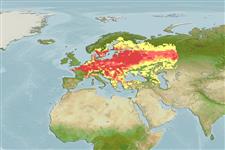Classificação / Names
Common names from other countries
Referência principal
Tamanho / Peso / Idade
Max length : 500 cm SL macho/indeterminado; (Ref. 59043); common length : 300 cm TL macho/indeterminado; (Ref. 9988); Peso máx. publicado: 306.0 kg (Ref. 9988); Idade máx. registada: 80 anos (Ref. 59043)
Length at first maturity
Lm 87.5, range 86 - 108 cm
Ambiente
; Água doce; estuarina bentopelágico; não migratória; intervalo de profundidade 0 - 30 m (Ref. 9988)
Clima / Intervalo
Temperate; 4°C - 20°C (Ref. 2059), preferred ?; 62°N - 36°N, 0°E - 80°E
Distribuição
Europe and Asia. North, Baltic, Black, Caspian and Aral Sea basins, as far north as southern Sweden and Finland; Aegean Sea basin in Maritza and from Struma to Sperchios drainages; Turkey. Absent from the rest of Mediterranean basin. Now widely introduced and translocated throught Europe and Lake Balkhash basin in Kazakhstan. Several countries report adverse ecological impact after introduction. In Appendix III of the Bern Convention (protected fauna).
Países | Áreas FAO | Ecossistemas | Ocorrências | Introduções
Descrição breve
Espinhos dorsais (total): 1; Raios dorsais moles (total): 4-5; Espinhos anais 1; Raios anais moles: 83 - 95. Distinguished from all other freshwater fishes in Europe by the following unique characters: two pairs of mental barbels; and anal fin with 83-91½ rays. Differs further from the following combination of features: body naked; large, depressed head; dorsal fin with 2-4½ rays; caudal fin rounded or truncate; no adipose fin; and anal rays almost touching caudal (Ref. 59043). Caudal fin with 17 rays (Ref. 2196).
Categoria na Lista Vermelha da IUCN (Ref. 115185)
Ameaça para o homem
Potential pest
Utilização humana
Pescarias: espécies comerciais; Aquacultura: espécies comerciais; peixe desportivo: sim
Ferramentas
Relatórios especiais
Descarregue XML
Fontes da internet
Estimates of some properties based on models
Phylogenetic diversity index
PD50 = 0.5001 many relatives (e.g. carps) 0.5 - 2.0 few relatives (e.g. lungfishes)
Nível Trófico
4.4 ±0.2 se; Based on diet studies.
Resiliência
Baixo, tempo mínimo de duplicação da população 4,5 - 14 anos (tm=3-4; tmax=30)
Vulnerabilidade
Very high vulnerability (84 of 100)
Categoria de preço
